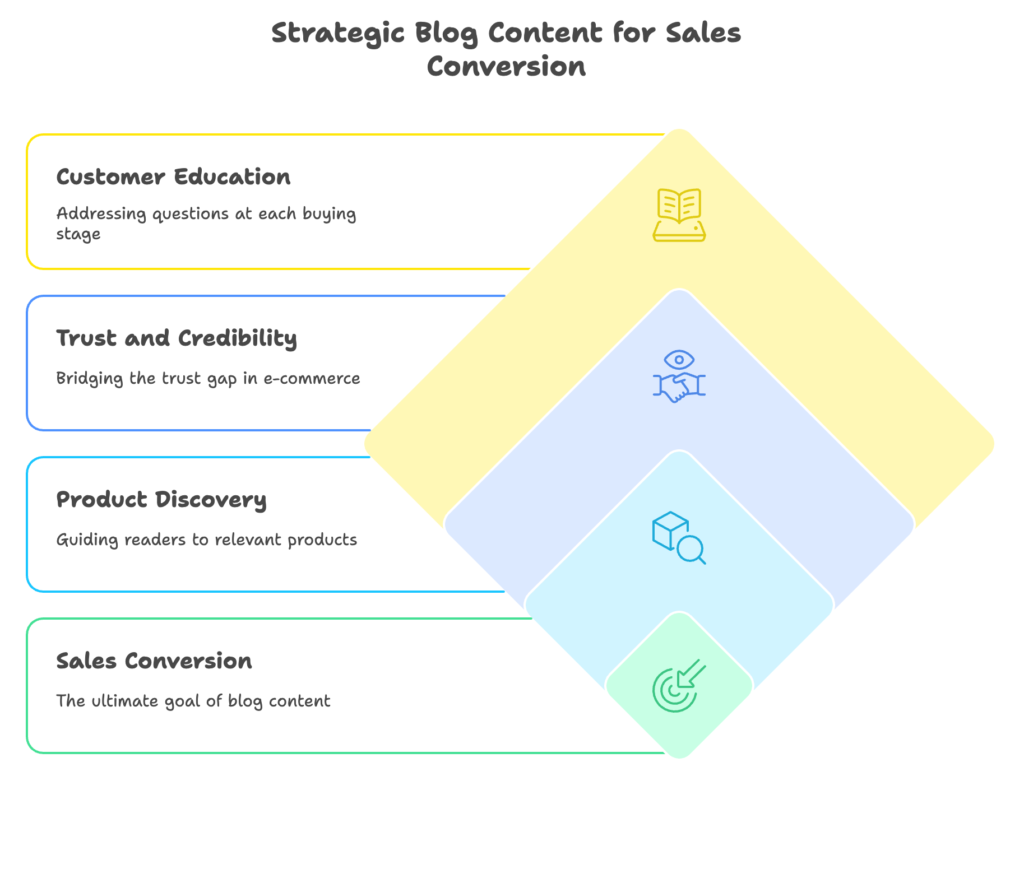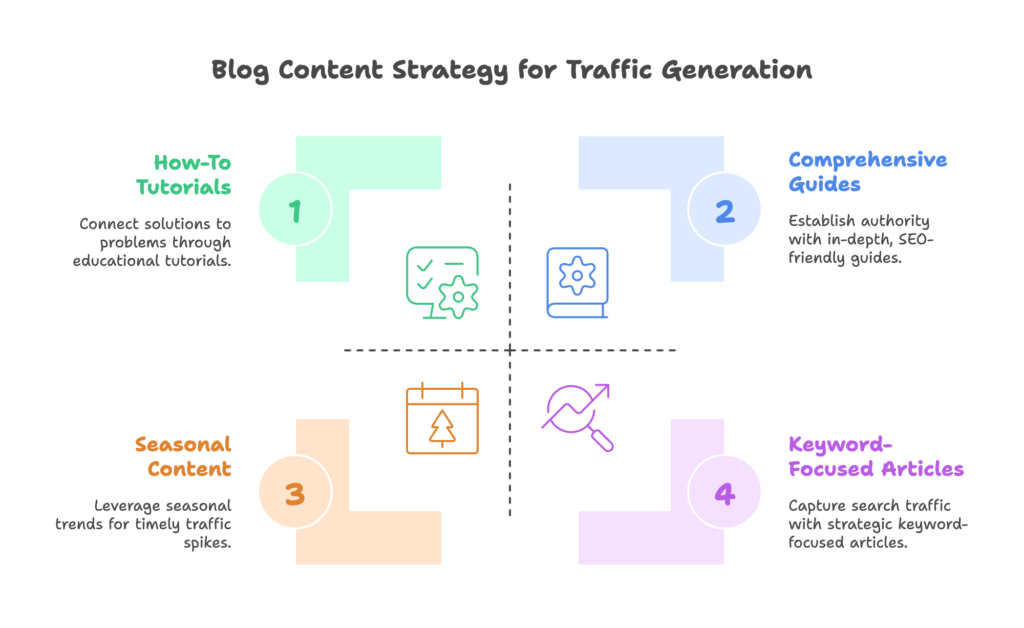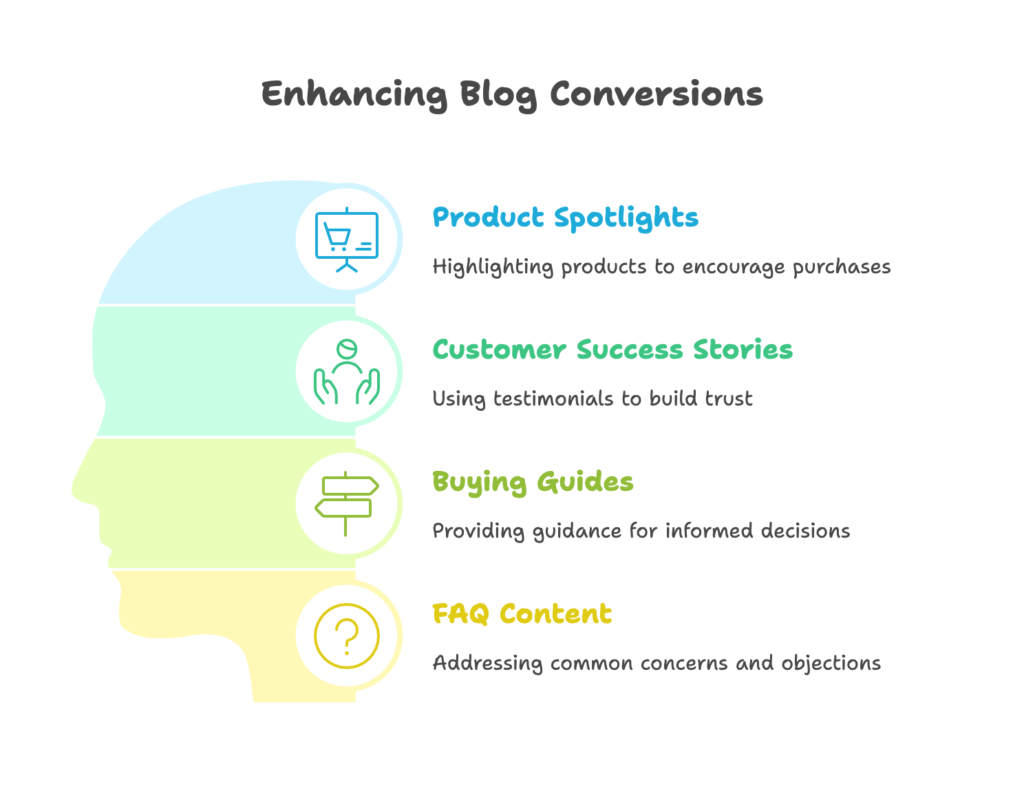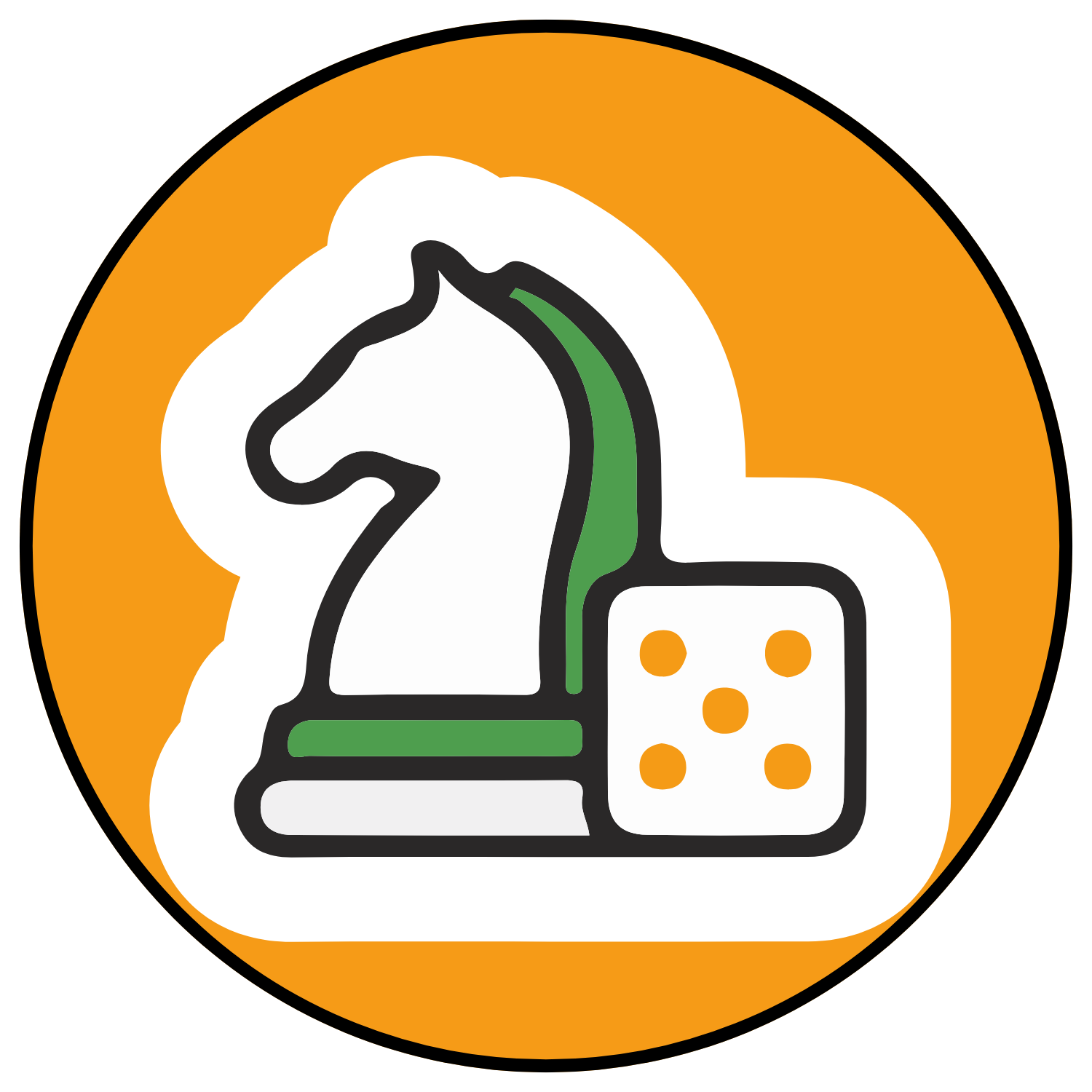Here’s a startling fact: Shopify stores with regularly updated blogs generate 55% more website traffic than those without. Yet many store owners treat blogging as an afterthought. They’re leaving money on the table—potentially your money.
Why do some Shopify merchants crush their sales goals month after month while others struggle to stay afloat? The answer often comes down to one critical difference: strategic content marketing through a well-executed blog. Not just any content, but specifically crafted posts that serve dual purposes: driving qualified traffic and converting that traffic into paying customers.
In this comprehensive guide, we’ll explore the blog content types that create this powerful traffic-to-sales pipeline. You’ll learn exactly what to publish, how to optimize it, and why certain content formats outperform others in the e-commerce space.
The Value Proposition of Blogging for E-commerce
Let’s cut to the chase: blogging isn’t just about sharing your thoughts. For Shopify store owners, it’s a strategic business tool with measurable ROI. But how exactly does it deliver value?
Traffic Generation Benefits
Every Shopify store faces the same fundamental challenge: getting eyes on your products. A well-executed blog solves this problem in three powerful ways:
- Improved SEO and organic visibility: Google loves fresh, relevant content. Each blog post creates another indexable page that can rank for keywords your potential customers are searching for. Unlike paid ads that stop delivering the moment you stop paying, blog content continues working for you 24/7, generating organic traffic month after month.
- Increased customer engagement: Blog content gives visitors a reason to spend more time on your site, decreasing bounce rates and sending positive signals to search engines. It also provides valuable content for social sharing, extending your reach without additional ad spend.
- Enhanced brand authority: When you consistently publish high-quality, informative content in your niche, you position your store as an authority. This builds credibility with both search engines and customers, leading to higher rankings and increased trust.
A jewelry store owner I worked with added just two blog posts weekly for six months. The result? Organic traffic increased by 138%, and they now rank on page one for over 200 relevant search terms—traffic that would cost thousands monthly through paid advertising.
Sales Conversion Potential
Traffic alone doesn’t pay the bills. Your blog needs to convert visitors into buyers.

Here’s how strategic blog content drives sales:
- Educating customers through the buying journey: Blog content can address questions and objections at every stage of the purchase decision. From awareness (“What are lab-grown diamonds?”) to consideration (“Lab-grown vs. natural diamonds: which is better?”) to decision (“Top 5 lab-grown diamond rings under $2,000”), you guide prospects toward a purchase.
- Building trust and credibility: E-commerce has an inherent trust barrier—customers can’t physically touch your products before buying. Detailed blog content helps bridge this gap by demonstrating your expertise and genuine understanding of customer needs.
- Supporting product discovery: Smart internal linking within blog posts naturally guides readers toward relevant products. Unlike pushy sales tactics, this approach feels helpful rather than promotional.
One home goods Shopify store implemented a buying guide strategy that led to a 24% conversion rate from blog readers to customers—nearly four times their site average.
Understanding the Shopify Blogging Ecosystem
Before diving into content types, let’s get familiar with Shopify’s blogging capabilities. Understanding the platform’s strengths and limitations will help you maximize results.
Shopify’s Native Blog Functionality
Shopify comes with built-in blogging tools that, while not as robust as dedicated platforms like WordPress, offer everything you need to create a successful content marketing strategy:
- Default “News” blog structure: Shopify automatically creates a “News” blog when you set up your store. This can be renamed to something more relevant to your brand (like “The Jewelry Guide” or “Coffee Culture”).
- Multiple blog creation capabilities: You can create multiple separate blogs within one Shopify store. This allows you to segment content by theme or audience (e.g., “Product Guides,” “Customer Stories,” and “Industry News”).
- Template customization options: Shopify themes include blog post templates that can be customized to match your brand aesthetic and improve readability. Some advanced themes offer additional blog features like related posts, author bios, and category filtering.
While these native features will serve most stores well, larger operations might eventually consider headless setups that combine Shopify’s e-commerce power with more advanced content management systems.
Setting Strategic Blog Goals
Random blogging rarely delivers results. Before creating your first post, establish clear objectives:
- Defining clear objectives: Are you primarily seeking to drive traffic, engage existing customers, educate your market, or directly promote products? Different goals require different content approaches.
- Aligning blog content with business objectives: Your blog should directly support your overall business strategy. Launching a new product line? Your blog calendar should build awareness and education around those products in the months leading up to launch.
- Measuring success through Shopify analytics: Set up tracking to measure how blog content influences your business. Shopify Analytics can show traffic sources, while Google Analytics provides deeper insights like which blog posts lead to purchases.
With this foundation laid, let’s explore the specific blog content types that will transform your Shopify store’s traffic and conversion rates.
Foundational Blog Content Types for Traffic Generation
The journey from zero to profitable blog starts with traffic generation. Without visitors, even the most persuasive content can’t drive sales. These fundamental content types form the backbone of your traffic acquisition strategy.

Educational How-To Guides and Tutorials
People don’t wake up thinking about your products. They wake up thinking about their problems. Educational content connects these problems to your solutions in a non-promotional way that search engines love.
Product Usage Tutorials
Don’t just sell products—show customers how to get maximum value from them. This creates both pre-purchase confidence and post-purchase satisfaction:
- Step-by-step instructions with visuals: Break down processes into clear, manageable steps with accompanying images or GIFs. For example, a skincare brand might create “How to Layer Serums for Maximum Results” with close-up application photos.
- Problem-solving approaches: Address common challenges your customers face. A kitchen gadget store could publish “5 Ways to Use Your Air Fryer for Perfect Vegetables Every Time” or “Troubleshooting Guide: Why Your Bread Machine Loaf Isn’t Rising.”
- Advanced techniques for product maximization: Help customers level up their usage. A craft supply store might share “Advanced Embroidery Techniques Using Our Beginner Kit” to show the long-term value of their entry-level products.
These tutorials not only rank well for specific long-tail keywords but also demonstrate that you genuinely care about customer success, not just making the sale.
Industry Knowledge Guides
Position your store as a trusted resource by creating comprehensive guides that educate beyond just your products:
- Beginner-friendly introductions to complex topics: Break down intimidating subjects into accessible explanations. A coffee shop might create “Coffee Brewing Methods Explained: Finding Your Perfect Cup” to help newcomers navigate options.
- Expert insights on industry trends: Share your perspective on developments in your field. A sustainable fashion store could publish “The Evolution of Eco-Friendly Fabrics: What to Look For in 2025.”
- Comprehensive resources that establish authority: Create definitive guides that answer every question on a topic. A home fitness equipment store might develop “The Complete Guide to Setting Up a Home Gym in Any Space” with sections for apartments, garages, dedicated rooms, etc.
One outdoor gear Shopify store created a series of hiking guides for different regions. Their “Complete Beginner’s Guide to Desert Hiking” ranks #1 for several valuable keywords, bringing in 12,000+ monthly visitors—many of whom go on to purchase hiking gear.
SEO-Optimized Keyword-Focused Articles
Traffic generation requires strategic keyword targeting. These content types are specifically designed to capture search traffic:
Strategic Keyword Research Techniques
Effective keyword research is the foundation of traffic-generating content:
- Identifying high-volume, low-competition terms: Focus on specific phrases that enough people search for but that aren’t dominated by major competitors. Instead of targeting “women’s shoes” (extremely competitive), a boutique footwear store might target “comfortable wedding guest shoes for outdoor ceremonies” (more specific with clearer purchase intent).
- Analyzing customer search intent: Understand why someone is searching for a term. Are they looking to buy, learn, compare, or solve a problem? A search for “best moisturizer for dry skin” indicates someone in the research phase, while “buy cerave moisturizing cream” shows purchase intent.
- Utilizing tools like Ahrefs or SEMrush: These platforms help identify valuable keywords and analyze competitor content. Look for “keyword gaps”—terms your competitors rank for that you don’t yet target.
Don’t just chase search volume. A highly relevant term with 200 monthly searches but clear purchase intent often delivers better ROI than a broad term with 2,000 searches but vague intent.
Content Clustering Strategy
Modern SEO success relies on comprehensive topic coverage, not just individual keyword targeting:
- Creating pillar content around core themes: Develop in-depth, authoritative articles (1,500+ words) on your main topics. A natural skincare Shopify store might create pillar content on “Natural Ingredients for Anti-Aging Skincare” that covers multiple ingredients comprehensively.
- Developing supporting articles that link to main pillars: Create shorter, more focused articles that explore subtopics in depth. The skincare store might then create individual posts about specific ingredients like “Bakuchiol: The Natural Retinol Alternative” or “How Vitamin C Brightens Skin,” each linking back to the pillar content.
- Building topical authority through comprehensive coverage: When Google sees your site thoroughly covering all aspects of a topic with quality content, it increasingly views you as an authority, boosting rankings across related keywords.
This cluster approach helped one home decor Shopify store increase organic traffic by 340% in six months by thoroughly covering subtopics around “sustainable home decor” with interconnected content.
Trend Analysis and Industry News
Staying current creates timely traffic opportunities and positions your brand as an industry leader:
Market Trend Breakdowns
Help your audience make sense of changes in your industry:
- Data-driven insights on emerging patterns: Share analysis backed by statistics and research. A beauty store might publish “5 Skincare Trends Gaining Momentum in 2025 (Based on Google Search Data)” with graphs showing rising interest in specific ingredients or techniques.
- Expert commentary on industry shifts: Provide perspective on why certain trends are emerging and what they mean. A home fitness equipment store could share “Why Home Gyms Are Evolving Beyond Cardio Equipment: Industry Expert Analysis.”
- Practical applications for Shopify merchants: Translate trends into actionable advice. A fashion boutique might create “How to Incorporate 2025 Color Trends Into Your Everyday Wardrobe” with specific product recommendations.
Trend content has a shorter lifespan but can generate significant traffic spikes when timed correctly.
Seasonal Content Planning
Capitalize on predictable seasonal interests:
- Holiday preparation guides: Publish content 1-3 months before major holidays when people begin searching. A kitchen supply store might share “Thanksgiving Dinner Prep: Essential Tools for Stress-Free Hosting” in early October.
- Seasonal product spotlights: Highlight products particularly relevant to upcoming seasons. A skincare brand could create “Winter Skincare Essentials: Preventing Dry, Flaky Skin When Temperatures Drop.”
- Timely promotions tied to current events: Connect products to timely happenings. A sports equipment store might publish “Train Like an Olympian: Home Workout Equipment Inspired by This Year’s Games” during Olympic seasons.
Plan seasonal content well in advance—it’s difficult to rank for competitive seasonal terms if you publish too close to the event itself.
Conversion-Focused Blog Content Types
Traffic is just the beginning. These content types are specifically designed to move readers from casual browsers to confident buyers.

Product Spotlights and Showcases
Strategic product-focused content educates while gently nudging toward purchase:
In-Depth Product Reviews
Reviews from your own team offer valuable insights while highlighting product benefits:
- Detailed feature analysis: Thoroughly explain how products work and what makes them special. A tech accessory store might create “We Tested This Phone Case in Extreme Conditions: Here’s What Happened” with stress test results and photos.
- Comparison with alternatives: Honestly address how your products stack up against others—including potential drawbacks. A coffee equipment store could publish “Chemex vs. French Press: Which Brewing Method is Right for You?” covering strengths and weaknesses of each.
- Real-world usage scenarios: Show products in authentic situations. A clothing brand might share “I Wore These Travel Pants for a 14-Hour Flight: Honest Review” with comfort ratings for different activities.
The key here is genuine helpfulness. When readers sense you’re prioritizing their needs over making a quick sale, trust and conversions naturally follow.
Product Collection Roundups
Group related products to solve specific customer problems:
- Thematic groupings: Curate products around seasons, occasions, or aesthetics. A home goods store might create “Creating a Minimalist Home Office: Essential Pieces for Focus and Productivity.”
- Problem-solution pairings: Address specific challenges with product combinations. A skincare store could publish “The Complete Acne-Fighting Routine: Products for Every Step.”
- Cross-selling opportunities through related products: Suggest complementary items that enhance the main product. A kitchen supplies store might share “Beyond the Stand Mixer: 7 Attachments That Transform Your Baking Game.”
A houseplant Shopify store increased average order value by 34% after implementing a “Complete Care Collections” blog series that grouped related plant care products together.
Customer Success Stories and Case Studies
Nothing converts like social proof. Real stories from real customers build confidence in hesitant shoppers:
Testimonial-Based Narratives
Transform basic reviews into compelling narratives:
- Before-and-after scenarios: Visually document the transformation your products enable. A skincare brand might share “Sarah’s 90-Day Journey Using Our Acne System” with timeline photos and detailed progress notes.
- Specific results and outcomes: Focus on measurable impacts. A fitness equipment store could highlight “How James Built a Complete Home Gym for Under $500 and Lost 30 Pounds.”
- Emotional connection points: Capture the emotional benefits beyond practical results. A custom jewelry store might share “The Story Behind This Mother-Daughter Necklace Set” featuring the personal meaning behind a customer’s purchase.
Always get permission before featuring customers, and consider offering incentives for those willing to share detailed stories.
Problem-Solution Frameworks
Structure case studies to highlight your products as problem-solvers:
- Common customer challenges: Begin with relatable problems your target audience faces. A sleep product store might start with “Mark Hadn’t Slept Through the Night in Years Due to Back Pain.”
- Product application as solution: Detail how specific products addressed the problem. Continuing the example: “After researching options, he tried our ergonomic pillow system designed for side-sleepers.”
- Measurable results and benefits: Conclude with concrete outcomes. For instance: “Within two weeks, Mark reported sleeping 7+ hours uninterrupted and waking without stiffness for the first time in a decade.”
These structured stories help potential customers envision similar results in their own lives, significantly reducing purchase hesitation.
Buying Guides and Decision Support Content
Complex purchase decisions need guidance. These content types help customers feel confident in their choices:
Comparison Articles
Help customers navigate options with clear, fair evaluations:
- Feature-by-feature analysis: Break down product differences in easy-to-scan tables or charts. A coffee equipment store might create “Drip Coffee Makers: Comparing 5 Popular Models” with a detailed feature matrix.
- Best-for-specific-needs recommendations: Match different customer profiles to ideal products. A running shoe store could share “Choosing Running Shoes: Best Options for Different Foot Types and Running Styles.”
- Value proposition clarification: Explain why price differences exist and when spending more makes sense. A cookware store might publish “Carbon Steel vs. Cast Iron Pans: When Each Is Worth the Investment.”
Even when comparing your own products, maintain objectivity. Customers appreciate honesty about which options suit different needs rather than always pushing the most expensive choice.
FAQ and Common Concerns Addressed
Proactively remove purchase barriers with thorough answers:
- Pre-purchase questions answered: Address common questions that arise before buying. A furniture store might create “Everything You Need to Know Before Buying a Sofa: Materials, Measurements, and Delivery Questions Answered.”
- Objection handling through content: Identify and address hesitations directly. A premium skincare brand could publish “Is Expensive Skincare Worth It? Breaking Down Ingredients and Results to Decide What’s Right for You.”
- Technical specifications explained simply: Make complex details understandable. A tech accessory store might offer “What Those Smartphone Camera Specs Actually Mean for Your Photos: A Plain English Guide.”
One outdoor gear store saw a 27% increase in conversion rate for their tent category after publishing a comprehensive “Tent Buying Guide” that addressed common sizing and weather-resistance concerns.
Visual and Interactive Blog Content Types
In a scrolling culture with shrinking attention spans, visual and interactive content captures interest and drives engagement in ways text alone cannot.
Video-Enhanced Blog Posts
Video content significantly increases time on page and can explain complex concepts more efficiently than text:
Product Demonstrations
Show your products in action for maximum impact:
- Unboxing experiences: Create excitement about the product arrival experience. A subscription box company might film the complete unboxing process, highlighting packaging details and first impressions of each item.
- Feature showcases: Demonstrate key functionality in action. A kitchen gadget store could show “5 Ways This Mandoline Slicer Transforms Your Vegetable Prep” with before-and-after efficiency comparisons.
- Usage tutorials integrated with written content: Combine video demonstrations with step-by-step written instructions. A cosmetics brand might create “Perfect Winged Eyeliner for Beginners” with a video tutorial followed by detailed written tips for different eye shapes.
Keep product demonstration videos under 2-3 minutes to maintain engagement, focusing on benefits rather than just features.
Behind-the-Scenes Content
Build brand connection through transparency and storytelling:
- Production processes: Show how your products are made. A handcrafted jewelry brand might film “From Raw Metal to Finished Piece: The Making of Our Signature Necklace” highlighting craftsmanship details.
- Team introductions: Humanize your brand with staff features. A small business might create “Meet Our Product Designer: The Story Behind Our Best-Selling Collection” to build personal connection.
- Brand story elements: Share your company journey and values. A sustainable clothing brand could document “How We Transformed Recycled Ocean Plastic Into Your Favorite Activewear.”
These authentic glimpses behind the curtain build trust and emotional connection that generic product listings simply cannot achieve.
Infographic-Centered Articles
Visual information processing is 60,000 times faster than text. Infographics capitalize on this for quick comprehension:
Data Visualization Posts
Transform complex information into instantly understandable visuals:
- Industry statistics presented visually: Make numbers meaningful through graphs and charts. A sustainable living store might create “The Environmental Impact of Single-Use Plastics: Visualized” with compelling comparative graphics.
- Process flows and decision trees: Guide decision-making with visual pathways. A skincare brand could offer “Find Your Perfect Moisturizer: Decision Tree Based on Skin Type and Concerns” to simplify product selection.
- Comparison charts for product features: Present complex feature comparisons at a glance. A tech accessories store might develop “Smartphone Protector Comparison: Which Offers Best Drop Protection?” with visual impact ratings.
Ensure infographics are mobile-responsive, as many users will view them on smaller screens.
Visual Guides and Checklists
Simplify complex processes with visual instructions:
- Step-by-step visual instructions: Break processes into illustrated steps. A crafting store might create “Visual Guide to Perfect Cross-Stitch for Beginners” with close-up images of each technique.
- Preparation checklists: Help customers prepare for activities or purchases. A camping equipment store could offer “Printable Family Camping Checklist: Everything You Need for a Stress-Free Trip” with categorized visuals.
- Visual troubleshooting guides: Help customers solve common problems. A coffee equipment brand might develop “Diagnosing Espresso Machine Issues: Visual Troubleshooting Guide” with symptom illustrations and solutions.
Make these visual assets downloadable or printable when appropriate to provide extra value and encourage social sharing.
Interactive Content Elements
Interactive elements transform passive readers into active participants:
Quizzes and Assessments
Engage visitors while collecting valuable insights:
- Product recommendation tools: Create quizzes that match customers to ideal products. A skincare brand might offer “Find Your Perfect Routine: Skin Type Assessment” that recommends specific products based on answers.
- Knowledge tests with personalized results: Educate while entertaining. A coffee shop could create “Test Your Coffee Knowledge: From Novice to Connoisseur” with personalized recommendations based on expertise level.
- Interactive buying guides: Guide purchase decisions through a series of questions. A bedding store might develop “Build Your Perfect Sleep System Quiz” that helps customers create a personalized bedding set.
One beauty Shopify store reported that quiz participants converted at 3.5x the rate of other site visitors, while also providing valuable data on customer preferences.
Calculators and Tools
Provide practical value with interactive utilities:
- Sizing guides: Help customers find their perfect fit. A clothing brand might create an “Interactive Size Finder” that uses height, weight, and body shape to recommend size.
- ROI calculators: Demonstrate value through numbers. A home fitness equipment store could offer a “Fitness Investment Calculator” comparing the cost of their equipment to gym membership over time.
- Customization visualizers: Let customers see potential options. A home décor store might develop a “Room Color Visualizer” that shows how different paint colors would look in a space.
These tools not only drive engagement but also serve as powerful lead generation mechanisms when combined with email opt-ins for results.
User-Generated and Community-Building Content
Modern consumers crave authenticity and connection. These content types leverage your customer community to build trust and engagement.
Customer Spotlight and User-Generated Content
Let your customers become your most convincing advocates:
Customer Reviews and Testimonials
Transform basic reviews into compelling content:
- Curated review collections: Gather themed reviews to tell a larger story. A mattress company might publish “What Real Customers Say About Their First Week on Our Mattress” featuring various sleep improvement testimonials.
- Before-and-after showcases: Highlight visible results with customer permission. A home organization brand could create “Customer Transformations: Pantry Makeovers Using Our Storage System” with submitted photos.
- Real usage scenarios from customers: Share how products function in diverse real-world environments. An outdoor gear store might feature “Where Our Customers Take Their Hiking Boots: From Local Trails to Mount Kilimanjaro” with customer adventure stories.
Always get proper permission before featuring customer content, and consider offering incentives like discounts or feature spots for high-quality submissions.
User-Generated Content Campaigns
Actively encourage customers to create shareable content:
- Hashtag contests: Create branded hashtags and incentivize their use. A fashion boutique might run a “#StyleMyOutfit Contest” where customers share photos styling their purchases for a chance to win store credit.
- Photo submission features: Invite customers to submit product photos for blog features. A home décor brand could create a monthly “Customer Spaces” feature showcasing how products look in real homes.
- Customer story spotlights: Invite customers to share their experiences for dedicated features. A fitness equipment company might publish “Transformation Tuesday: Jane’s Home Workout Journey” highlighting customer achievements.
User-generated content campaigns create a continuous supply of authentic marketing material while making customers feel valued and connected to your brand.
Community Engagement Posts
Foster a sense of belonging around your brand:
Q&A Sessions and Expert Interviews
Bring in diverse perspectives to enrich your content:
- Industry expert insights: Interview specialists related to your products. A natural skincare store might publish “Dermatologist Interview: The Science Behind Anti-Aging Ingredients” with professional recommendations.
- Team member spotlights: Showcase the expertise behind your products. A coffee shop could feature “Meet Our Roaster: How She Selects and Develops Our Signature Blends” highlighting staff credentials.
- Customer question roundups: Compile and answer frequent customer inquiries. A tech accessory store might create “You Asked, We Answered: Top 10 Questions About Our New Phone Cases” addressing common concerns.
These posts not only provide valuable information but also demonstrate that real, knowledgeable humans stand behind your products.
Discussion-Provoking Content
Start conversations that engage your community:
- Opinion pieces on industry trends: Share thoughtful perspectives on developments. A sustainable fashion brand might publish “Is ‘Fast Fashion Recycling’ Really Sustainable? Our Take on the Latest Trend” inviting customer thoughts.
- Controversial topic explorations: Thoughtfully examine debated issues. A pet supply store could create “Raw vs. Kibble Diet: Exploring the Ongoing Debate” presenting multiple viewpoints.
- Community polls and surveys: Actively seek customer input. A home décor brand might share “Help Us Design Our Next Collection: Vote on Your Favorite Patterns” with interactive polling.
One beauty brand saw a 165% increase in comment engagement after implementing discussion-focused posts that asked specific questions at the end of each article.
Advanced Content Marketing Strategies for Shopify Blogs
Once you’ve mastered the fundamentals, these advanced strategies will help you maximize content ROI and build a sustainable traffic and sales engine.
Content Repurposing and Distribution
Extract maximum value from every piece of content you create:
Cross-Platform Content Adaptation
Transform blog content for different platforms and formats:
- Social media snippets from blog content: Extract key quotes, statistics, or tips from blog posts as social media graphics. A fitness equipment store might turn “5 Signs You Need to Replace Your Running Shoes” into a carousel of warning signs for Instagram.
- Email newsletter features: Repurpose blog content for email subscribers. A kitchenware store could transform a detailed “Knife Skills 101” blog post into a weekly series of shorter email tips with video clips.
- Video content derived from written posts: Convert popular articles into video format. A skincare brand might turn their “10-Step Korean Skincare Routine Explained” blog post into a step-by-step video tutorial.
Create a systematic approach to repurposing by planning multiple formats from the beginning. When outlining a blog post, simultaneously plan how it will transform into social posts, emails, and other media.
Strategic Content Promotion
Amplify your content’s reach through targeted distribution:
- Social media promotion tactics: Develop platform-specific promotion strategies. Share behind-the-scenes content on Instagram Stories while posting in-depth tutorial excerpts on LinkedIn, each linking back to the full blog post.
- Email marketing integration: Segment your email list to send the most relevant content to different customer groups. A home goods store might send “Small Space Organization Tips” only to subscribers who previously purchased apartment-sized furniture.
- Influencer amplification opportunities: Identify micro-influencers in your niche who might share your content. A sustainable clothing brand could reach out to eco-focused influencers when publishing comprehensive guides on sustainable fabric choices.
Create a promotion calendar for each piece of content, scheduling multiple shares across different channels over days, weeks, and even months for evergreen content.
Content Upgrades and Lead Generation
Transform content consumption into email list growth:
Downloadable Resources
Create valuable assets worth exchanging an email address for:
- Comprehensive guides and ebooks: Expand blog topics into detailed downloadable resources. A gardening supply store might offer a “Complete Season-by-Season Garden Planning Guide” as a PDF download in exchange for an email.
- Templates and worksheets: Create practical tools that help implement your advice. A business supply store could offer a “Productivity Planner Template” as a downloadable Excel or printable PDF alongside a blog post about workspace efficiency.
- Checklists and planning tools: Simplify complex processes with downloadable checklists. A camping equipment store might provide a “Family Camping Preparation Checklist” as a printable PDF complementing a blog post about family camping tips.
One home décor Shopify store added PDF room planning guides to their top blog posts, increasing email sign-ups by 320% while providing genuine value to readers.
Email Capture Strategies
Implement sophisticated approaches to list building:
- Content-specific opt-ins: Create unique offers relevant to each post. Readers of a “Beginner’s Guide to Skincare” might be offered a “Personalized Skincare Routine Builder” in exchange for their email.
- Segmented content offers: Tailor follow-up content based on interests demonstrated by blog reading habits. If someone reads multiple posts about kitchen organization, offer them an exclusive “Kitchen Organization Masterclass” email series.
- Progressive profiling through content: Gradually learn more about subscribers through their content interactions. After initial sign-up, use subsequent content offers to learn details like skin type, style preferences, or skill level.
Always deliver exceptional value in exchange for contact information. The quality of your email list matters far more than its size.
Content Optimization and Iteration
Continuous improvement drives long-term content ROI:
Performance Analysis
Regularly evaluate content effectiveness:
- Traffic and engagement metrics review: Identify which topics and formats drive the most pageviews, time on page, and social shares. A jewelry store might discover that “How to Measure Your Ring Size at Home” consistently outperforms other content types.
- Conversion path tracking: Analyze which content pieces lead to purchases. A kitchenware store might find that detailed comparative reviews convert at 4x the rate of general kitchen tips.
- Content ROI measurement: Calculate the return on investment for different content types. Track the time and resources spent creating content against the traffic and sales it generates over time.
Set up monthly content performance reviews to identify patterns and inform future content decisions.
Content Refreshing Strategy
Keep your content library current and high-performing:
- Updating outdated information: Regularly audit older posts for accuracy. A tech accessory store should update “Best Phone Protection for iPhone 12” when newer models are released.
- Expanding high-performing content: Add more depth to already successful posts. If a “Beginner’s Guide to Sourdough” performs well, expand it with additional techniques, troubleshooting tips, or recipe variations.
- Repurposing underperforming pieces: Transform content that didn’t resonate in its original form. A low-performing detailed technical post might work better as an infographic or video.
One furniture Shopify store implemented a quarterly content refresh strategy, updating their top 10 traffic-driving posts with new information and examples. This increased organic traffic by 28% without creating any new content.
Implementation and Management Best Practices
Even the best content strategy fails without proper implementation. These practical approaches will help you execute consistently and effectively.
Content Planning and Calendar Development
Consistent publication requires systematic planning:
Strategic Editorial Calendar
Organize your content production thoughtfully:
- Seasonal and promotional alignment: Schedule content to support key business initiatives. Plan gift guides 2-3 months before major holidays and product-focused content to coincide with launches or promotions.
- Content type variation: Balance different formats to maintain reader interest. Avoid publishing similar content types consecutively—mix educational posts with product features, case studies, and visual content.
- Keyword coverage planning: Systematically address your target keywords over time. Map out which posts will target specific search terms to ensure comprehensive coverage of your topic clusters.
Use a dedicated calendar tool (even a simple spreadsheet works) to visualize your content plan across months, ensuring balanced coverage of topics and formats.
Resource Allocation
Manage content creation efficiently:
- Writer assignment and management: Determine who will create each piece—whether internal team members or freelancers. Match content topics with subject matter experts when possible for the highest quality.
- Visual asset creation workflow: Establish processes for developing images, videos, and graphics. Create templates for common visual needs like featured images, infographics, or product comparison charts to streamline production.
- Publication and promotion scheduling: Plan not just when content will be published, but also how it will be promoted across channels. Create a standardized checklist for content promotion to ensure no opportunities are missed.
Be realistic about resources. Consistent quality matters more than quantity—it’s better to publish one excellent article weekly than five mediocre ones.
Technical Blog Setup and Optimization
Maximize your Shopify blog’s technical foundation:
Shopify Blog Configuration
Set up your blog for success:
- Template selection and customization: Choose a theme with strong blog functionality or customize your existing theme. Prioritize features like related posts, author information, and category filtering for better user experience.
- Comment management settings: Decide whether to enable comments and how to moderate them. Comments can build community but require active management to prevent spam.
- Navigation and categorization structure: Make content discoverable through logical categories and tags. Ensure your blog is easily accessible from your main navigation and includes search functionality.
Consider creating multiple blog sections if you serve distinct audience segments or cover vastly different topics. A store selling both hiking gear and photography equipment might maintain separate blog sections for each.
SEO Technical Optimization
Ensure search engines can properly index and rank your content:
- Meta title and description best practices: Craft unique, keyword-rich meta information for every post. Keep titles under 60 characters and descriptions under 155 characters to prevent truncation in search results.
- Image optimization techniques: Compress images for faster loading while maintaining quality. Always include descriptive alt text that includes relevant keywords where natural.
- Internal linking strategies: Connect related content through strategic internal links. Link to relevant products from blog posts and connect newer content to older evergreen posts to strengthen your site’s SEO architecture.
Regularly audit your technical SEO using tools like Google Search Console to identify and fix issues like broken links, missing meta descriptions, or slow-loading pages.
Measuring Success and Scaling Efforts
Track performance to continually improve your content strategy:
Key Performance Indicators
Monitor meaningful metrics to evaluate content effectiveness:
- Traffic metrics: Track sessions, page views, and time on page to assess content appeal and engagement. Analyze traffic sources to understand how visitors find your content.
- Engagement metrics: Monitor comments, social shares, and backlinks as indicators of content quality and relevance. High engagement often correlates with better search rankings over time.
- Conversion metrics: Measure how effectively content drives desired actions, whether email sign-ups, product page visits, or purchases. Set up Google Analytics goals to track progression from content consumption to conversion.
Develop a simple monthly dashboard combining these metrics to track progress and identify content types that deliver the best ROI.
Scaling Successful Content Approaches
Build on what works to grow your content operation:
- Content type performance analysis: Identify which formats consistently deliver results. If buyer guides consistently outperform other formats for conversions, allocate more resources to creating them.
- Topic expansion strategies: Build on successful topics with deeper coverage. If a basic “Coffee Brewing Guide” performs well, create dedicated posts for each brewing method mentioned.
- Team capacity building: Develop systems to increase content production while maintaining quality. Create templates, style guides, and standard operating procedures that allow you to delegate effectively.
As your blog grows, consider bringing specialized talent (writers, designers, SEO specialists) into your team, either as employees or freelancers, to maintain quality while increasing production.
References
- Onila Agency. (2024, May 20). Types of Content that Generate Traffic and Sales for Shopify Stores. https://onilagency.com/en/blogs/todo-shopify-y-ecommerce/tipos-de-contenidos-que-generan-trafico-y-ventas-para-tiendas-shopify
- Praella. (2024, November 29). Shopify Blogging Best Practices: Elevate Your Ecommerce Content Strategy. https://praella.com/blogs/shopify-insights/shopify-blogging-best-practices-elevate-your-ecommerce-content-strategy
- Praella. (2024, November 29). Effective Shopify Content Marketing Strategies for E-commerce Success. https://praella.com/blogs/shopify-insights/effective-shopify-content-marketing-strategies-for-e-commerce-success
- Shopify Support. (n.d.). Manage blogs for your online store. https://help.shopify.com/en/manual/online-store/blogs/adding-a-blog
Ready to supercharge your Shopify store’s sales with perfectly optimized discount campaigns? Growth Suite is a Shopify app that helps you run effective on-site discount and email collection campaigns. Its powerful data engine analyzes customer behavior to deliver the right offers at the right time, increasing conversions and revenue. The app creates personalized, time-limited discount codes that look and work like native features on your store. Install Growth Suite with a single click and start seeing results with the 14-day free trial!




